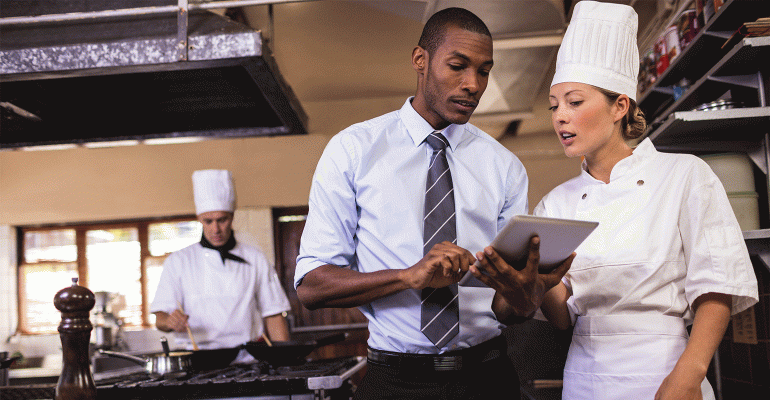Jim Sullivan is a popular keynote speaker at leadership, franchisee and GM conferences worldwide. This article does not necessarily reflect the opinions of the editors or management of Nation’s Restaurant News.
Short of being shot at and missed, nothing is quite as exhilarating as starting or running a successful restaurant. But as any foodservice operator will tell you, it grows more challenging with each new year. The restaurant business is the only business I know where there are more ways to lose money than make money. Tough new challenges around labor, rent, technology, training, and competition abound in 2020 and beyond. When you’re being squeezed by so many different factors, what are the critical things to do? My recent workshops with companies like Texas Roadhouse, Chipotle, Wendy’s and others have taught me that focusing on the 7 C’s in 2020 is the path to progress.
Clarity. As you unspool your business strategies for 2020, be aware that the most critical success factor is not planning, it’s prioritizing and executing. Most performance problems are rooted in a lack of strategic clarity and prioritization from the leadership team. Share your company plan, goals and targets throughout your organization at every level. Involve area managers by having them take the bigger goals and break them down into specific daily activities for implementation at the unit level. Share progress and scoreboards with the crew.
Communication. Critical things to communicate with your teams in 2020 include: progress toward company goals, key milestones achieved (and recognition of those who helped achieved them), and daily strategies for accomplishing incremental progress toward period or quarterly goals. In other words: pre-shift meetings and post-shift summaries of goal attainment or shortcomings. Define your promises, and promise only what you can deliver.
Commonality. Here are two questions to gauge your crew’s readiness: “Does everyone on our team know and understand our goals for 2020?” “Does everyone on our team understand their specific role in achieving those goals?” When commonality of purpose is clearly communicated to every team member, a binary choice emerges: they are either supporting the vision or supporting division.
Creativity. Perhaps the most creative thing you can do to propel your business forward in 2020 is to challenge the process. One of the hotter topics in business today is upskilling, reskilling, and redefining jobs for the future of foodservice work. Given the current impact of app ordering, third-party delivery, customer loyalty, predictive analytics, the rise of ghost kitchens and a shallow industry labor pool, now is the time for every foodservice operator to honestly re-assess every current training, development, throughput and operational process in place in their restaurants. Then, they need to determine if those processes and systems were made for a business that was or one that is going to be. Start with questions like: “Why do we do it this way?” “What if we did it a different way?” “What are the best operators doing differently that we’re not doing?” This thinking should also spill over into the hiring process and those you seek out as future leaders. As Henry Ford said in 1917, "I am looking for a lot of people who have an infinite capacity to not know what can’t be done.”
Consistency. In 2020 you and your management team must think long and hard about which specific behaviors and practices characterize above average performance in your restaurant teams. Figure out how to measure it, teach it, and align it to every position every shift so it can be repeated. Once you’ve identified those characteristics, search for people internally and externally who reflect that exceptional behavior. Most importantly, determine what kind of training they experienced. This will help you build stronger teams, separate the best from the rest and codify the behavior — and the coaching that made it happen — into your culture.
Coach. In over 25 years in this industry, I have never witnessed a spontaneous recovery from incompetence. If you don’t spend all your time training, you will spend all your time training. In 2020, invest in critical-thinking skills for all managers, chefs and shift leaders. Relative to employee performance, stop asking, “how can I get people to do what I want them to do?” A better question is, “why would my employees do what I want them to do?” When attempting to modify behavior, always lead with why it’s important and then detail what to do and how to do it. Never forget that the single most important source of competitive differentiation in the restaurant business is employee quality. Period.
Customer. The customer is why. A restaurant’s most important assets exit the building or drive-through every morning, noon or night. There are no cash registers in the home office for the simple reason that the restaurant is the most important component in any foodservice brand’s success. Make hiring your most important decision in 2020 because what you are really hiring is the customer experience.
Jim Sullivan is the most-booked keynote and workshop speaker in the foodservice industry today. He’s the author of two books (Multiunit Leadership and Fundamentals) that have sold over 300,000 copies worldwide. You can get his free leadership resources at Sullivision.com and join his 400,000 social media followers at LinkedIn, YouTube and Twitter.





